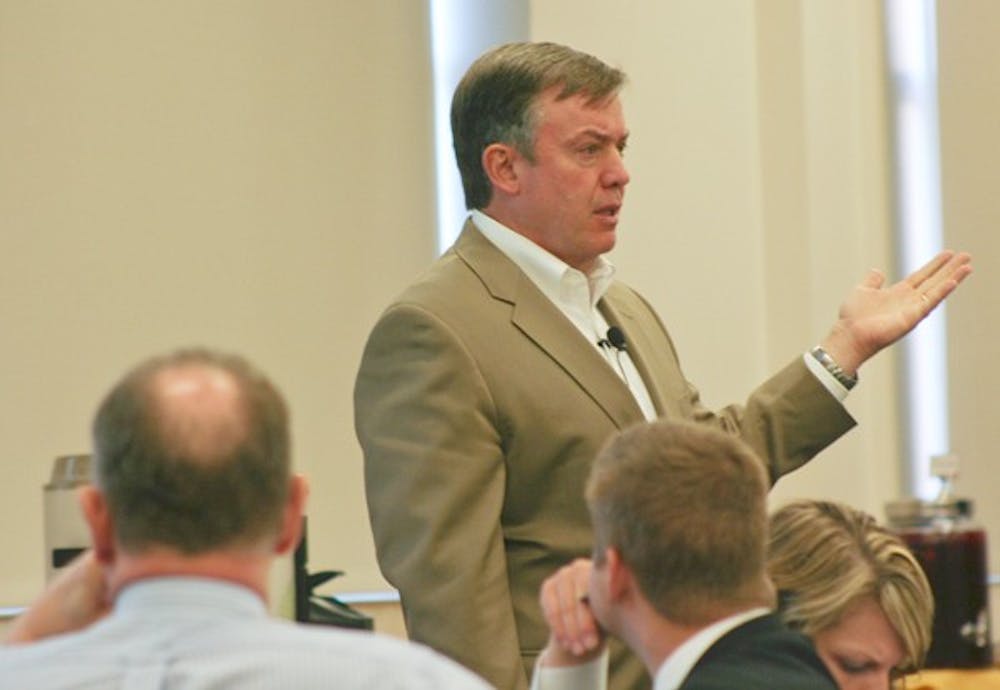In a special meeting of the Arizona Board of Regents on Tuesday, ASU President Michael Crow said the University is prepared to deal with significant budget cuts on the way.
“We've been in a force-4 hurricane for two and a half years,” he said. “It looks like it's continuing. So for us, it looks like normal weather."
The regents meeting was held to discuss strategies for handling a minimum budget cut of $170 million this year, and the university presidents each presented their plans.
In January, Gov. Jan Brewer proposed the $170 million cut to the university system, but regents said they fear that number might increase by up to another $75 million before being finalized by the state Legislature.
William “Brit” Kirwan, chancellor of the University System of Maryland, began the meeting by offering his expert opinion on the impact of funding reductions both nationally and in Arizona.
“You’re in uncharted territory,” he told the regents. “It may be time to look at some major shifts in consolidating operations to an extent that hasn’t been done before.”
Kirwan stressed the importance of innovative solutions in order to continue offering quality, affordable education in Arizona.
“We’re caught on the horns of a terrible dilemma,” he said. “We’re committed to access and [having] a large proportion of the state population with a degree, but on the other hand we don’t want to do damage to the quality of education we offer.”
However, regents and university presidents agree that it can be done with minimal impact to students’ wallets, but that real and painful decisions must be made.
The Board pledged that the university system will absorb $100 million in cuts before even considering tuition increases.
Each university has been assigned a portion of the $100 million to cut. Beyond that number, each institution must determine how it will deal with its part of the remaining $70 million.
All three university presidents told regents they don’t plan to rely solely on tuition increases to make up the remaining $70 million.
Based on current estimates, Crow told regents ASU could manage these cuts by increasing tuition $450 for most undergraduate students. UA President Robert Shelton proposed a $1,400 increase and NAU President John Haeger said he will not seek a tuition increase for most students.
"We are not going to advance the burden of financing the University on resident undergraduate tuition,” Crow said. “But what that means is that the management of ASU better be good.”
Crow said he will request a differential tuition model, meaning tuition will be higher for some programs than others. He identified nursing, engineering and journalism among the high-cost programs that could require higher tuition. Tuition for lower-cost programs, including those at the Polytechnic and West campuses, could see lower tuition in comparison.
NAU’s Haeger said his university can balance its share of the cuts without increasing tuition for 65 percent of undergraduate students and while retaining its tuition pledge, which guarantees students no increases for four years after enrollment.
This plan would require dipping substantially into NAU’s financial reserves, which are larger than the other universities. This plan caused debate among the regents.
Board chairwoman Anne Mariucci said the universities made a promise to cut $100 million without dipping into reserves. Regent Mark Killian disagreed, saying NAU is the only university with substantial enough reserves to use this way, and it should not be penalized for doing so.
"Why can't we buy down the cost of tuition increases by using some of the reserves?" he said. "How do we say to people 'We're going to raise your tuition, and oh, by the way, we've got a bag of cash over here'?"
By the end of the day, the Board decided reserves could be used to counter tuition increases, but not to offset a university’s portion of the $100 million cuts.
Regents also agreed they want to preserve financial aid.
"I cannot support any cost-cutting or any sort of trimming programs that cut financial aid," Regent Ernest Calderón said.
Calderón applauded Crow for looking at all options to help keep tuition increases minimal.
"He's not going to take [tuition] from $8,000 to $13,000, which he could very well make an argument for,” he said.
All three universities also talked about slashing costs by reducing employee benefits in some way.
The broad idea of cutting salaries or benefits was added to the Board’s list of strategies for reducing costs, and a committee was formed to investigate the best approach before ABOR’s April meeting.
Crow said past salary cuts and furloughs bought time, but didn’t really save the University any money.
Official tuition proposals for all three universities will be released next week, and the Board will vote on them during an April 7 and 8 meeting.
ABOR will also hold a tuition hearing on March 28 to accept public comment on the proposals.
Kirwan told the regents to consider all ideas because the situation in Arizona will require a mix of solutions and a reengineering of the way the universities deliver education.
“There are some strategies out there already, but we have to increase focus and attention on establishing a new paradigm,” he said. “I’m going to be watching you with great interest to see how you deal with this situation. You’re at the cutting edge of this problem and I think we can all learn from you.”
Reach the reporter at keshoult@asu.edu





